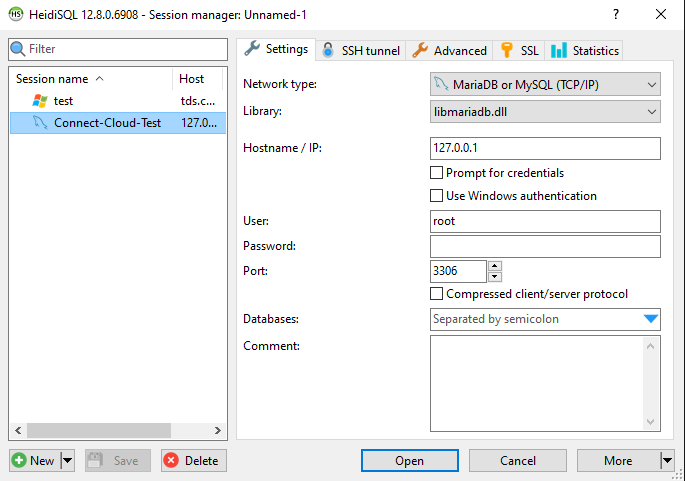Discover how a bimodal integration strategy can address the major data management challenges facing your organization today.
Get the Report →Connect to AlloyDB Data from HeidiSQL
Use CData Connect Cloud to connect to and query live AlloyDB data from HeidiSQL.
HeidiSQL is an open-source database administration tool that natively supports MariaDB, MySQL, SQL Server, and PostgreSQL. When paired with CData Connect Cloud, HediSQL reach extends to include access to live AlloyDB data. This article demonstrates how to connect to AlloyDB using Connect Cloud and query AlloyDB data in HeidiSQL.
CData Connect Cloud provides a pure SQL Server interface for AlloyDB, allowing you to query data from AlloyDB without replicating the data to a natively supported database. Using optimized data processing out of the box, CData Connect Cloud pushes all supported SQL operations (filters, JOINs, etc.) directly to AlloyDB, leveraging server-side processing to return the requested AlloyDB data quickly.
Configure AlloyDB Connectivity for HeidiSQL
Connectivity to AlloyDB from HeidiSQL is made possible through CData Connect Cloud. To work with AlloyDB data from HeidiSQL, we start by creating and configuring a AlloyDB connection.
- Log into Connect Cloud, click Connections and click Add Connection
- Select "AlloyDB" from the Add Connection panel
-
Enter the necessary authentication properties to connect to AlloyDB.
The following connection properties are usually required in order to connect to AlloyDB.
- Server: The host name or IP of the server hosting the AlloyDB database.
- User: The user which will be used to authenticate with the AlloyDB server.
- Password: The password which will be used to authenticate with the AlloyDB server.
You can also optionally set the following:
- Database: The database to connect to when connecting to the AlloyDB Server. If this is not set, the user's default database will be used.
- Port: The port of the server hosting the AlloyDB database. This property is set to 5432 by default.
Authenticating with Standard Authentication
Standard authentication (using the user/password combination supplied earlier) is the default form of authentication.
No further action is required to leverage Standard Authentication to connect.
Authenticating with pg_hba.conf Auth Schemes
There are additional methods of authentication available which must be enabled in the pg_hba.conf file on the AlloyDB server.
Find instructions about authentication setup on the AlloyDB Server here.
Authenticating with MD5 Authentication
This authentication method must be enabled by setting the auth-method in the pg_hba.conf file to md5.
Authenticating with SASL Authentication
This authentication method must be enabled by setting the auth-method in the pg_hba.conf file to scram-sha-256.
Authenticating with Kerberos
The authentication with Kerberos is initiated by AlloyDB Server when the ∏ is trying to connect to it. You should set up Kerberos on the AlloyDB Server to activate this authentication method. Once you have Kerberos authentication set up on the AlloyDB Server, see the Kerberos section of the help documentation for details on how to authenticate with Kerberos.
![Configuring a connection (Salesforce is shown)]()
- Click Create & Test
-
Navigate to the Permissions tab in the Add AlloyDB Connection page and update the User-based permissions.
![Updating permissions]()


Add a Personal Access Token
If you are connecting from a service, application, platform, or framework that does not support OAuth authentication, you can create a Personal Access Token (PAT) to use for authentication. Best practices would dictate that you create a separate PAT for each service, to maintain granularity of access.
- Click on your username at the top right of the Connect Cloud app and click User Profile.
- On the User Profile page, scroll down to the Personal Access Tokens section and click Create PAT.
- Give your PAT a name and click Create.
- The personal access token is only visible at creation, so be sure to copy it and store it securely for future use.

Connect to AlloyDB from HeidiSQL using Connect Cloud
To establish a connection from HeidiSQL to the CData Connect Cloud Virtual SQL Server API, follow these steps.
Create a new HeidiSQL Session
- In the Session Manager, select New in the bottom-left
- Give the new session a descriptive name, e.g. Connect-Cloud-AlloyDB

Configure a SQL Server Connection to Connect Cloud
- In the session settings, set the Network type to Microsoft SQL Server (TCP/IP)
- The Library DLL should automatically update to MSOLEDBSQL
- Set the Hostname/IP to tds.cdata.com
- Set the User to your CData Connect Cloud username. This is displayed in the top-right corner of the CData Connect Cloud interface. For example, [email protected]
- Set the Password to your PAT created in Connect Cloud in the previous section.
- Set the Port to 14333
![Configuring a SQL Server connection to Connect Cloud]()
Query AlloyDB from HeidiSQL
- In the database listing on the left, find your connection to AlloyDB configured earlier.
- Expand this connection to view individual tables or data objects present within AlloyDB.
- Write custom SQL queries targeting these tables, treating the data source like any SQL Server database, or visually explore each tabular data set by selecting the relevant tables
![Querying within HeidiSQL.]()
Get CData Connect Cloud
To get live data access to 100+ SaaS, Big Data, and NoSQL sources directly from your SQL Server database, try CData Connect Cloud today!










